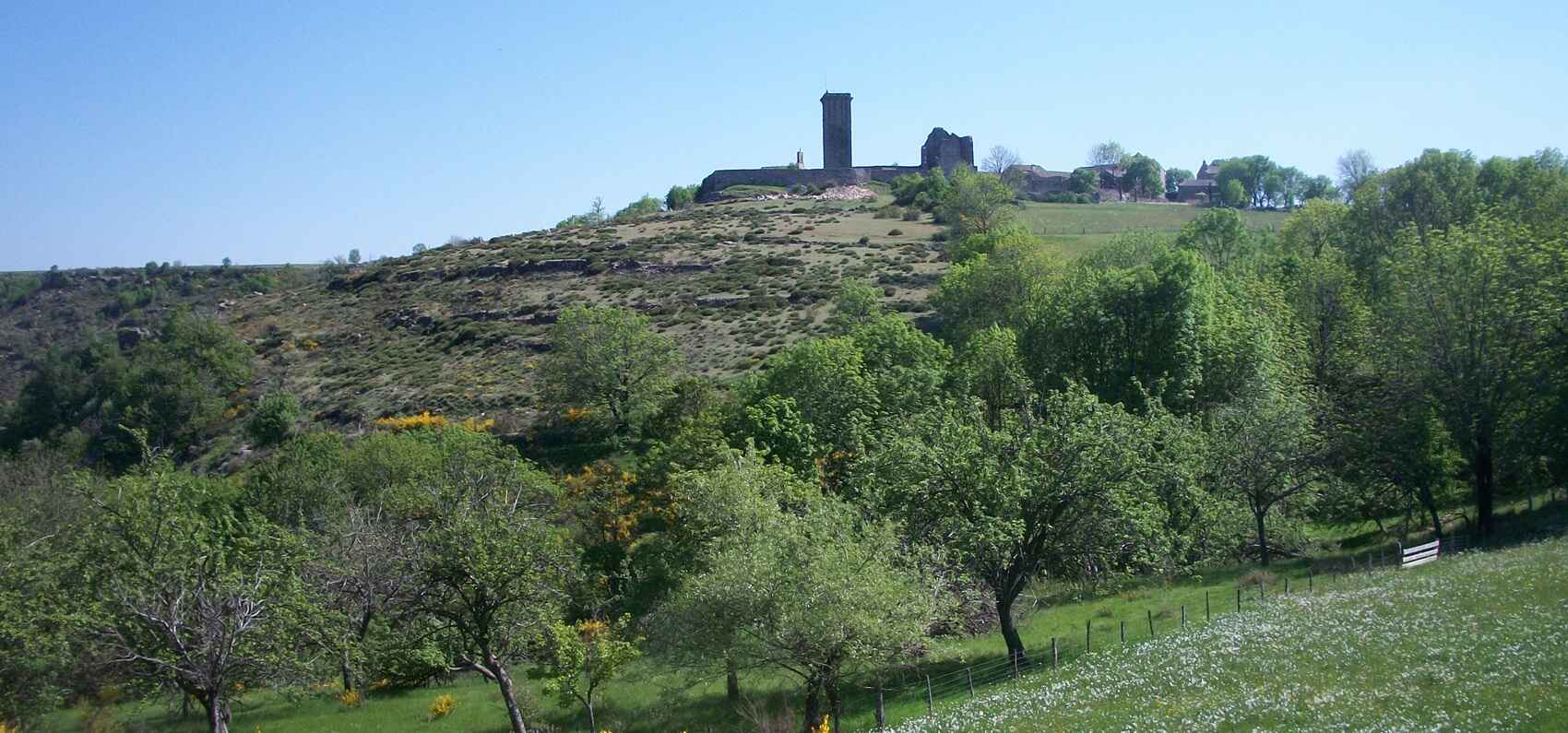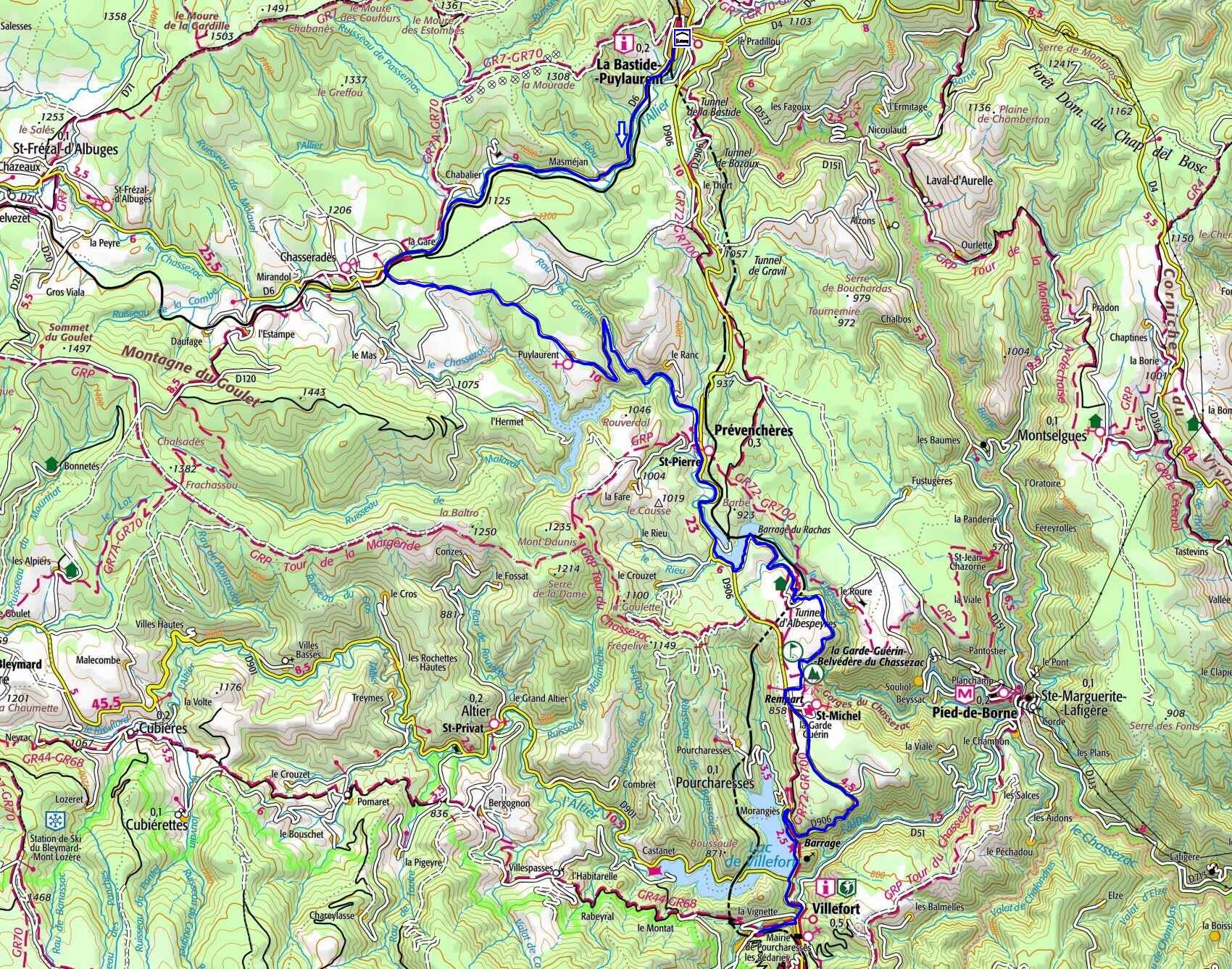37km bike tour at La Bastide-Puylaurent |
Take the D6 along the Allier via Les Huttes, Masmejean, the Château de Chabaleyret, Chabalier and the Chasserades train station. 500 metres further on, turn left, cross the level crossing and continue on this small road for 10.3 km to Prevencheres via Grossefage and Puylaurent. Turn right onto the D906 which you follow for 3.2 km. Just after the Rachas dam, turn left towards Albespeyres by the greenway to La Garde-Guerin 6 km further on. You will find the D906 which you will follow to Villefort. Take the street which goes up on the right towards the train station. Return by train (Train timetables).

20,5km - 25km - 27,7km - 30km - 35,2km - 37km - 41,5km - 44km - 48,4km - 57,5km - 59,4km - 60km - 60,5km - 69km - 70km - 76,8km - 77km - 81km - 90km - 95,7km
Google Maps - Google Earth - GPX








Distance: 37km. Maximum altitude: 1162m. Minimum altitude: 574m. Cumulative elevation gain: 491m.
IGN maps: La Bastide-Puylaurent (2738E). Mont Lozere Florac PN des Cevennes (2739OT). Largentiere la Bastide-Puylaurent Vivarais Cevenol (2838OT).
Print the route - Electric bike rental
Is it Puylaurent or St Laurent du Fraisse? Both of these names are noted in old documents, with perhaps a predominance of the "Podium Laurentii". After the Celts came the Gauls, the Romans and the Franks. Closer to us, various authorities have succeeded or overlapped: the king, very distant, the bishop, powerful lords, such as the Randon de Chateauneuf, then the Randon de Luc who became the "Polignac", later the Morangies, etc. The castle; it existed and is mentioned in 1265. Around the 1600s, there remained the ruins of a tower. A priory of Benedictine monks, a subsidiary of the great abbey of St Gilles, existed in Prevencheres and the simple priory of Puylaurent was attached to it. Lasting links therefore existed between the two parishes. History cannot forget them. After being a parish for a millennium, then the capital of a commune, Puylaurent is now just a hamlet in the commune of La Bastide.
In the heart of the valleys bathed in light, where the blue periwinkle blooms, lies Prevencheres, a green setting with Celtic origins. In the past, our ancestors saw healing powers in the delicate periwinkle, a touch of magic in its azure petals. Trade between merchants on the Via Regordane was a vital aspect of the medieval economy. This historic road served as an important commercial link between the north and south of France, facilitating the trade of goods such as wool, leather, salt and spices. Prevencheres, located on this route, was a strategic crossing point for merchants. The region benefited from the economic activity generated by the flow of goods and the cultural interactions that resulted from it. Merchants used relays and inns to rest and exchange products, but also information and ideas.
The Chassezac is a French river that flows through the departments of Lozere, Gard and Ardeche. The Chassezac is 84.6 kilometres long. It rises in the department of Lozere, about 20 km east of Mende, on the western flank of the Moure de la Gardille (1,503 m) in the Margeride mountains, in the north of the commune of Saint-Frezal-d'Albuges. Its source is close to that of the Allier, which feeds the Atlantic slope and whose source is on the eastern flank of the Moure de la Gardille. The Chassezac begins by flowing generally towards the south, crisscrossing the commune of Saint-Frezal-d'Albuges in a wide loop. It serves as the southern boundary of this commune with that of Belvezet for about 2.6 km, taking a general direction towards the south-east which it keeps until its confluence. Downstream, it crosses the communes of Chasserades, Prevencheres and Puylaurent. The Mirandol railway viaduct is located immediately upstream of Chasserades. Further on, it meets the Puylaurent hydroelectric dam, shared between the communes of Prevencheres and La Bastide-Puylaurent. Its reservoir has two branches: that of the Chassezac coming from the north-west and that of the Malaval stream coming from the south and entirely located on Prevencheres.
La Garde-Guerin is a fortified village located in the Lozere department in the Occitanie region. It is perched on a rocky plateau in a magnificent location and is one of the many attractive little villages to discover in the Cevennes National Park. The village is crossed by the Chemin de Regordane (GR700), an almost unique communication route linking the Massif Central to the Mediterranean, very busy in the Middle Ages. Originally, this path was known as l’ Estrade (Occitan estrada, "main road", from the Latin strata). In the 12th century, at the request of the Bishop of Mende, the village became a border post defended by a garrison responsible for the safety of travelers and goods on the Regordane. Throughout the 13th century, this place was simply called La Garde. The name Guerin only appears in 1298. The fortified village, or castrum of La Garde, is owned in co-seigneury by a community of knights los Pariers (in Occitan: "the Equals", from the Latin pares), an economic and military community in the spirit of the Schools of Chivalry flourishing in France from the 12th century who swear an oath to the Bishop of Mende. Each parier owns a parerie, also called part or portion, for which he assumes responsibility and collects the income: toll, cartelage (right on the measurement of grain), guidance and protection of travelers, animals and goods on the portion of the Regordane road that they maintained, spraying (right on the dust raised by the herds of animals).
Former holiday hotel with a garden along the Allier, L'Etoile Guest House is located in La Bastide-Puylaurent between Lozere, Ardeche, and the Cevennes in the mountains of Southern France. At the crossroads of GR®7, GR®70 Stevenson Path, GR®72, GR®700 Regordane Way, GR®470 Allier River springs and gorges, GRP® Cevenol, Ardechoise Mountains, Margeride. Numerous loop trails for hiking and one-day biking excursions. Ideal for a relaxing and hiking getaway.
Copyright©etoile.fr